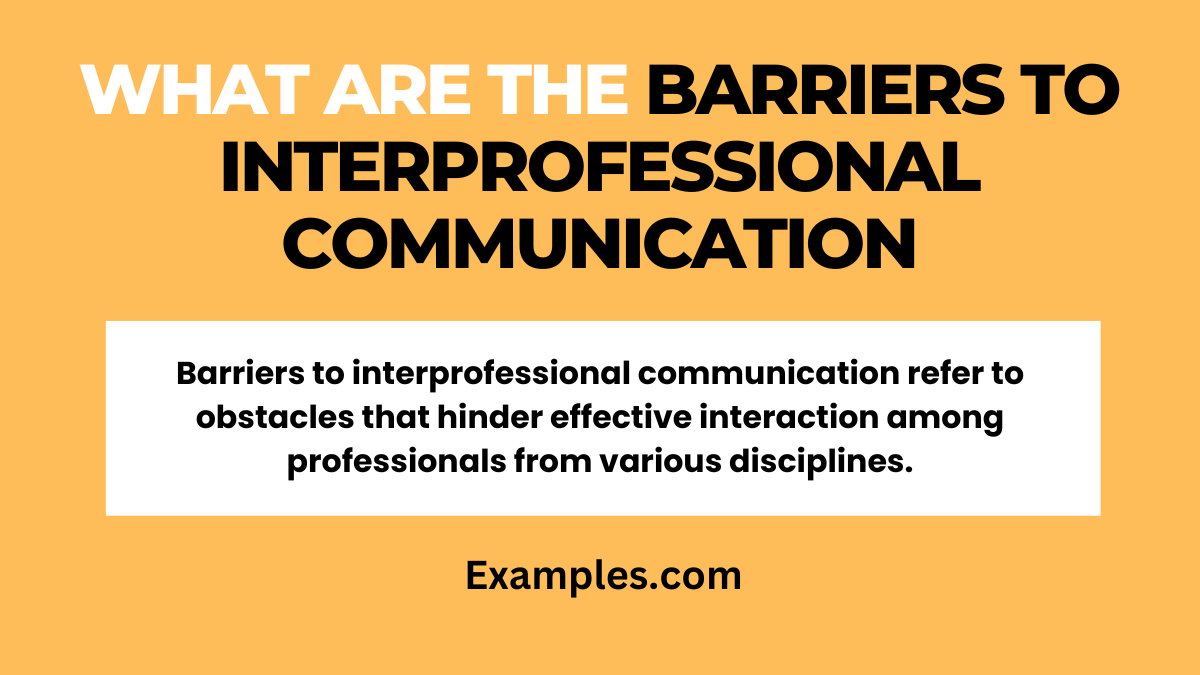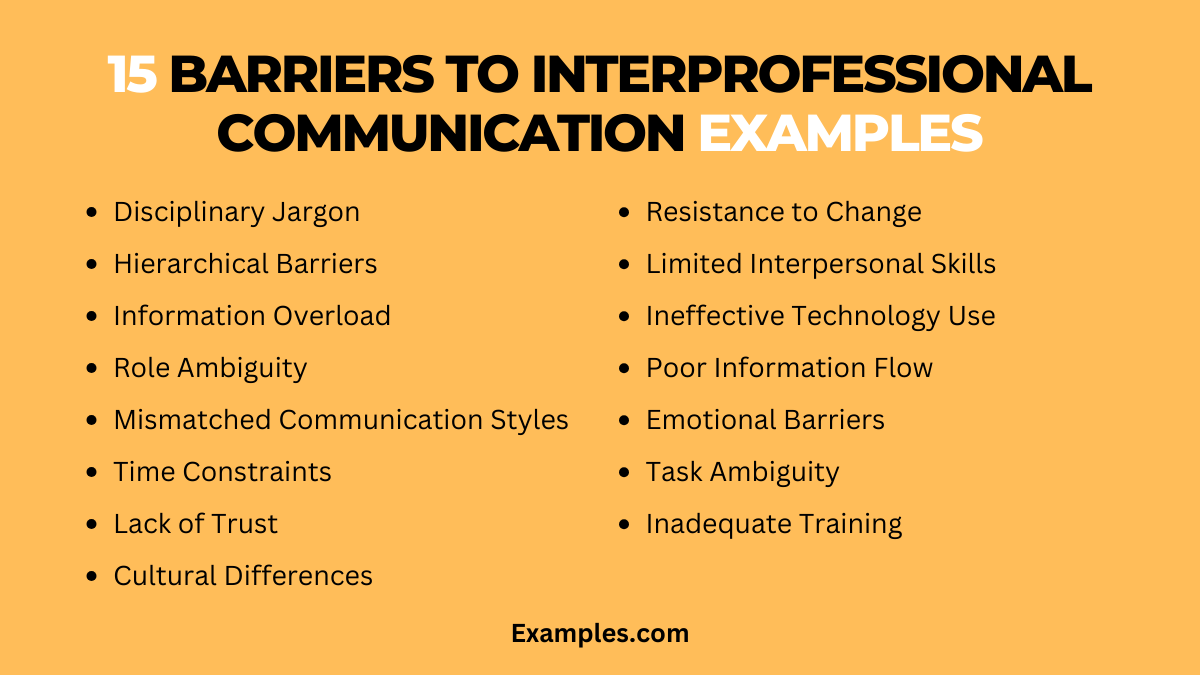Barriers to Inter professional Communication
Embark on a comprehensive journey into the intricacies of interprofessional collaboration with our guide on “Barriers to Interprofessional Communication.” Delve into the challenges faced in hospital and workplace settings, navigating through real-world Communication Examples. Uncover strategies to overcome these barriers, fostering effective teamwork and enhancing communication skills across diverse professional landscapes. This guide serves as your roadmap to mastering the art of interprofessional communication, crucial for success in today’s collaborative work environments.
What are the Barriers to Interprofessional Communication

Barriers to interprofessional communication refer to obstacles that hinder effective interaction among professionals from various disciplines. In simpler terms, these challenges impede the seamless exchange of information, ideas, and expertise between team members in diverse work environments, including hospitals and workplaces. Recognizing and addressing these barriers is crucial for fostering collaboration, teamwork, and ultimately, delivering optimal outcomes in interprofessional settings. This guide demystifies these complexities, offering clarity on the hindrances and strategies to overcome them.
15 Barriers to Interprofessional Communication Examples
Explore the multifaceted landscape of interprofessional communication barriers, identifying impediments that impact collaborative efforts. From misaligned communication styles to hierarchical challenges, grasp the intricacies hindering seamless interaction and learn strategies to enhance teamwork in diverse professional environments.

- Disciplinary Jargon: Misuse of technical terms hinders understanding.
Example: Clarify medical terminology to ensure all team members comprehend patient needs. - Hierarchical Barriers: Power differentials impact open communication.
Example: Encourage nurses to share insights during team discussions to break down hierarchy. - Information Overload: Excessive data can lead to confusion and oversight.
Example: Summarize critical information for concise and effective communication. - Role Ambiguity: Unclear responsibilities hinder task execution.
Example: Clearly define roles to avoid confusion, ensuring everyone understands their specific contributions. - Mismatched Communication Styles: Differing approaches create misunderstandings.
Example: Adapt communication styles to resonate with diverse team members for effective collaboration. - Time Constraints: Rushed schedules limit in-depth discussions.
Example: Schedule regular team meetings to provide a dedicated platform for comprehensive communication. - Lack of Trust: Doubt impedes open dialogue.
Example: Foster trust through team-building exercises to encourage transparent communication. - Cultural Differences: Diverse backgrounds can lead to misinterpretations.
Example: Embrace cultural awareness training to navigate diverse communication norms. - Resistance to Change: Unwillingness to adapt hampers progress.
Example: Implement change gradually, ensuring clear communication about the benefits and goals. - Limited Interpersonal Skills: Weak social dynamics hinder collaboration.
Example: Invest in interpersonal training to enhance communication and build stronger team bonds. - Ineffective Technology Use: Poor utilization of communication tools disrupts workflow.
Example: Train staff on effective use of communication technology to streamline information sharing. - Poor Information Flow: Blocked channels impede the exchange of vital information.
Example: Implement an accessible digital platform for real-time data sharing among team members. - Emotional Barriers: Unaddressed emotions impact teamwork.
Example: Encourage an open-door policy to discuss and manage emotions constructively within the team. - Task Ambiguity: Unclear objectives lead to misalignment.
Example: Clearly outline project goals, ensuring everyone comprehends the desired outcomes. - Inadequate Training: Insufficient preparation hampers communication.
Example: Conduct regular training sessions on effective communication strategies for all team members.
Barriers to Interprofessional Communication at Hospital
Dive into the challenges specific to healthcare settings, unveiling barriers that impede effective interprofessional communication within hospitals. Explore the nuances of collaborative efforts among healthcare professionals and discover strategies to enhance communication for optimal patient care.
- Shift Change Chaos: During shift changes, miscommunication may occur.
Example: Ensure a detailed handover report to mitigate misunderstandings and maintain patient safety. - Diverse Specializations: Varied medical expertise can lead to communication gaps.
Example: Encourage interdisciplinary training sessions for shared understanding of each specialist’s role. - Emergency Situations: High-stress situations demand clear and swift communication.
Example: Practice regular emergency drills to streamline communication protocols and response. - Multidisciplinary Rounds: Inefficient rounding processes can hinder information exchange.
Example: Implement structured multidisciplinary rounds for comprehensive patient updates and collaboration. - Electronic Health Record Challenges: Navigating EHR complexities can impede data sharing.
Example: Provide EHR training to ensure seamless information retrieval and transmission.
Barriers to Interprofessional Communication at Work
Uncover the obstacles hindering effective interprofessional communication in the workplace. Explore challenges arising from diverse professional backgrounds and hierarchies, and discover strategies to foster open dialogue, collaboration, and productivity.
- Communication Style Variances: Differing work styles can lead to misunderstandings.
Example: Conduct team-building exercises to understand and adapt to various communication preferences. - Remote Work Challenges: Virtual collaboration demands effective digital communication.
Example: Implement video conferencing tools and clear communication protocols for remote team cohesion. - Project Ambiguity: Unclear project goals affect teamwork.
Example: Develop detailed project briefs to ensure everyone comprehends objectives and expectations. - Cross-Functional Teams: Interdepartmental collaboration may face obstacles.
Example: Facilitate cross-functional team-building sessions to break down silos and encourage shared goals. - Limited Feedback Culture: Lack of constructive feedback hinders growth.
Example: Establish regular feedback sessions to encourage open communication and professional development.
What are the Challenges of Interprofessional Collaboration
Delve into the intricate world of interprofessional collaboration and explore the challenges that professionals encounter in collaborative work environments. This comprehensive guide unveils the nuances of these obstacles, providing insights into the complexities hindering seamless teamwork and communication among diverse disciplines.
- Understanding the Landscape of Interprofessional Collaboration: Grasping the foundational aspects of interprofessional collaboration, emphasizing its significance in modern workplaces and healthcare settings.
- The Dynamics of Team Hierarchy: Exploring how hierarchical structures within teams can impede open communication and collaboration, and strategies to foster a more egalitarian environment.
- Communication Style Variances: Addressing the diverse communication preferences and styles among professionals and offering techniques to bridge the gaps for effective teamwork.
- Barriers in Information Sharing: Unveiling the challenges associated with sharing vital information among team members, focusing on strategies to ensure seamless data exchange.
- Overcoming Disciplinary Jargon: Tackling the misuse of technical language and jargon within specialized fields, emphasizing the need for clear communication for cross-disciplinary understanding.
In conclusion, this guide illuminates the intricate landscape of interprofessional communication barriers. By exploring real-world examples and offering actionable strategies, professionals can navigate challenges in diverse settings. Embrace the insights provided to foster effective collaboration, enhance communication skills, and ultimately cultivate a harmonious and productive interdisciplinary environment.



